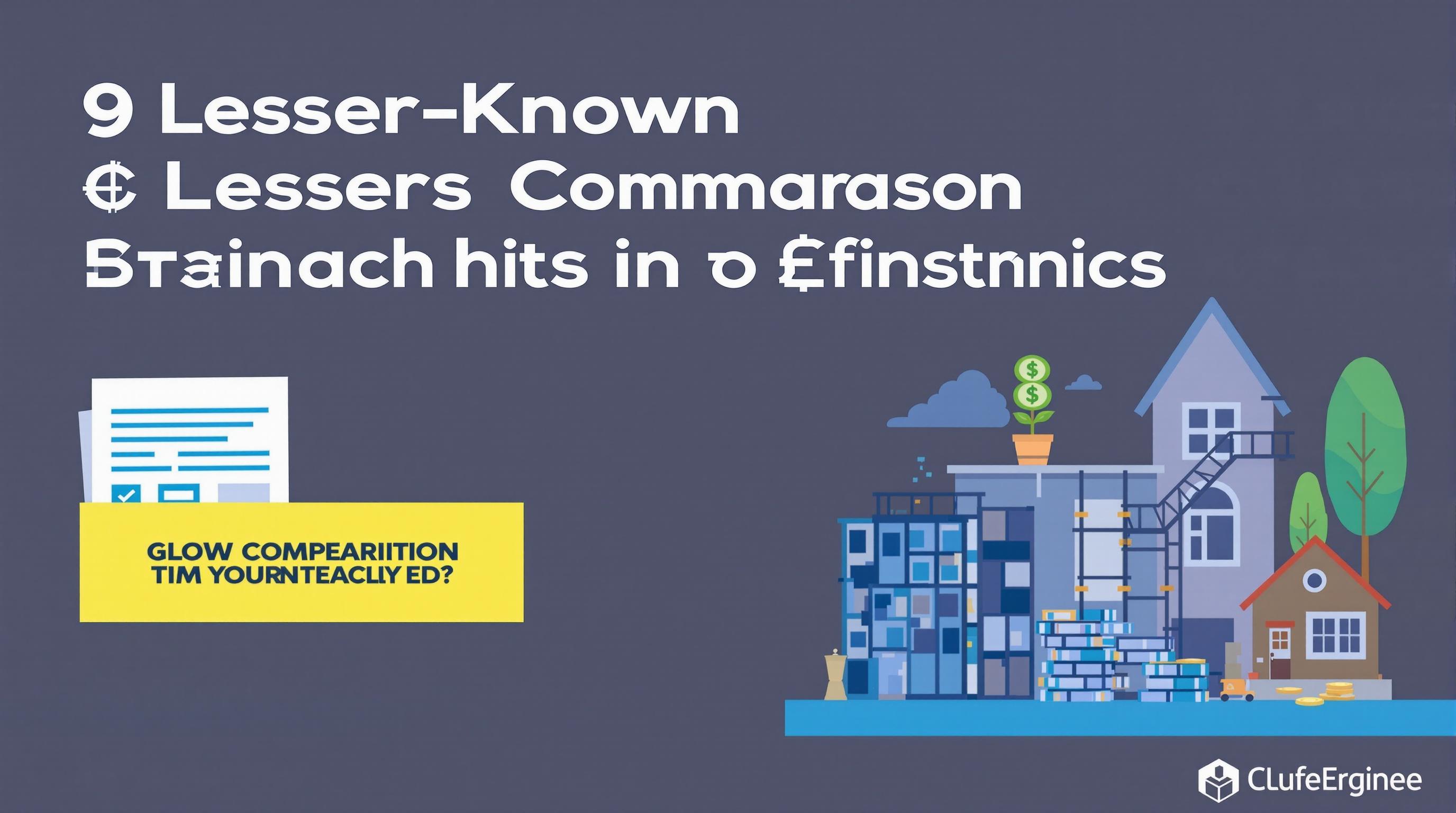Related Articles
- Top 6 Niche Credit Cards from the Past Five Years That Exploit Unseen Reward Loopholes
- Unmasking the Silent Influence of Social Media Challenges on Long-Term Financial Behavior and Credit Recovery
- How Microcredit Dynamics in Remote Communities Are Redefining Access and Trust Beyond Traditional Credit Metrics
- How Cultural Attitudes Shape Collective Borrowing Habits and Their Impact on Financial Unification Strategies
- Top 5 Under-the-Radar Digital Loan Services Launched Since 2019 That Are Disrupting Traditional Borrowing Norms
- Top 6 Cutting-Edge Financial Wellness Platforms Redefining Debt Recovery Tools Released Since 2019
Unveiling the Shadow Costs in Loan Choices: How Hidden Fees and Fine Print Skew Borrower Decisions
Unveiling the Shadow Costs in Loan Choices: How Hidden Fees and Fine Print Skew Borrower Decisions
Choosing a loan isn’t just about the interest rate — hidden fees and fine print often lead borrowers down a costly path they didn’t expect. This article dives into the shadow costs lurking in loan agreements, revealing how they skew borrower decisions and offering insights to navigate them wisely.
Case Study: Meet Jake, a 29-year-old entrepreneur who thought he secured a great business loan at a seemingly attractive 6% interest rate. However, after signing, he discovered an origination fee of 3%, monthly maintenance costs, and hefty prepayment penalties buried deep in the contract. What initially appeared affordable spiraled into a financially draining experience that almost jeopardized his startup’s survival.
Understanding the Fine Print: More Than Just Legal Jargon
Financial institutions rarely make the fine print obvious. This volume of terms, often measured in pages, includes fees, penalties, and conditions that typically escape cursory reading. According to a 2021 survey by the Consumer Financial Protection Bureau, 65% of borrowers admitted to only skimming loan contracts, unaware of clauses that increased their repayments by up to 15%.
From origination fees, late payment charges, processing fees, to insurance costs that can be mandatory – lenders embed these costs within the contract, silently elevating the loan’s overall expense. These “shadow costs” can sometimes surpass the headline interest rate cost, making a seemingly cheap loan surprisingly expensive over time.
The Quirky World of Loan Fees: Let’s Make It Fun(ish)
Imagine walking into a store to buy a $100 jacket but then paying an extra $20 “hanger fee,” $15 “fabric softener charge,” and a $10 “tag removal tax” — all mandatory. Sounds ridiculous, right? Yet, similar sneaky fees exist in loans! Borrowers get hit with mysterious charges: “processing fees” that make no sense or “administrative costs” that feel like they pay for the lender’s coffee breaks.
It’s like a financial treasure hunt with all the treasures being costs you didn’t expect. The lesson? Always ask, and ask again, about every fee associated with a loan before committing.
Interest Rates vs. Total Cost: The Big Blind Spot
Borrowers often focus solely on interest rates, comparing, for instance, 5% versus 7%. But the total cost of borrowing — known as the Annual Percentage Rate (APR) — includes fees and compounding interest over the loan term. The difference between the nominal interest rate and APR can be significant. A 5% interest rate coupled with 5% in fees can translate to closer to 10% APR, misleading borrowers who don’t look deeper.
To illustrate: A $10,000 personal loan with a 5% stated interest rate but $500 in hidden fees can wind up costing well over $11,000 when fees and interest are tallied, not just $10,500 as the base calculation would suggest.
The Psychological Trap: Why Hidden Costs Affect Decisions
Behavioral economics tells us that consumers tend to underestimate complex costs and overemphasize simple numbers like “monthly payment.” This can lead to the “anchoring bias,” where borrowers focus on the monthly repayment figure that the lender highlights, ignoring nuanced, long-term expenses.
Rebecca, a 42-year-old mother of two, shared her story: “They told me my monthly payment would be just $250. What they didn’t emphasize was the balloon payment at the end and the expensive late payment fees that buried me.” Unfortunately, Rebecca’s narrative echoes across thousands of stories captured in a 2019 national study on consumer debt.
Regulation and Transparency: Are Lenders Doing Enough?
While regulations like the Truth in Lending Act (TILA) enforce disclosure of APR, many argue that these measures fall short.
Complex fee structures and legal language often still confuse consumers. The Federal Reserve’s 2022 report emphasized that 40% of borrowers fail to fully understand loan disclosures, underscoring the ongoing challenge.
Financial watchdogs continue to press for simpler contracts and clearer, upfront cost breakdowns — but until then, consumer vigilance remains key.
Tips for Borrowers: Navigating the Loan Jungle
- Request a full cost breakdown: Don’t accept just the interest rate — get all fees itemized in writing.
- Calculate the APR yourself: This provides a more accurate picture than advertised interest alone.
- Ask about penalties: Clarify charges for late payment, prepayment, or refinancing early.
- Read online reviews and seek peer advice: Borrowers often share hidden pitfalls experienced with specific lenders.
- Get professional advice: Financial counselors or loan officers unaffiliated with the lender can offer unbiased opinions.
Spotlight on Payday and Title Loans: A Cautionary Tale
Loans with short repayment periods, such as payday or car title loans, are notorious for hidden fees and rapid compounding. Their interest rates are astronomical, but less obvious are their fees which often trap borrowers in cycles of debt.
Consider the story of Mike, a 35-year-old factory worker who took a $500 payday loan. While the promised APR was 400%, additional fees and rollovers made it effectively closer to 650%, a financial quagmire that forced him to refinance repeatedly over months.
This example darkly illustrates how undisclosed or confusing fees are weaponized, preying on vulnerable borrowers in urgent need, perpetuating debt spirals.
Statistical Snapshot: The Costly Impact of Hidden Fees
According to a 2023 report by the National Consumer Law Center, hidden fees add an average of 12-18% to the cost of loans for low- and moderate-income borrowers. Extrapolated nationally, this amounts to billions of dollars flowing from consumers’ pockets to lenders annually—all without clear borrower awareness.
The report emphasizes the disproportionate burden on marginalized groups who may have limited credit options, furthering socioeconomic inequalities.
The Role of Technology: Can It Help Unmask the True Loan Cost?
Younger borrowers, especially Millennials and Gen Z, increasingly turn to fintech platforms promising transparency through algorithmic fee disclosures and APR calculators. Apps that analyze loan offers and flag suspicious terms are gaining popularity.
However, these tools depend on accurate input data; if lenders aren’t upfront, the algorithms can only work with limited information. As such, technology is a vital aid but not a panacea.
Conversational Reflection: Let’s Get Real About Loans
Okay, so let’s chat like friends over coffee. You see a cool loan ad pop up—“Low rates! Easy approval!” Sounds great, huh? But what’s the catch? It’s those pesky “other” fees they barely mention, making your wallet scream silently.
Trust me, I learned this tough lesson when I was 24 and grabbed a "great deal" for a car loan. The monthly payments looked perfect until surprise fees turned my budget upside down. Moral of the story? Be suspicious in a friendly way. Dig, ask, triple-check.
Honestly, loans should not feel like ambushes. They’re tools to enable dreams and opportunities, not financial traps. So, be your own advocate.
Final Thoughts: Empowered Borrowing Through Awareness
Loans with hidden fees and complex fine print distort borrower decision-making, often leading to financial hardship. However, armed with knowledge, healthy skepticism, and careful scrutiny, consumers can protect themselves and make smarter choices.
As the lending landscape evolves with regulatory pressures and technology advances, borrowers must remain informed and proactive. Remember, the best loan deal isn’t the one with the flashiest headline—it's the one you fully understand.
Sources:
Consumer Financial Protection Bureau (2021). “Borrower Behavior and Loan Contract Understanding.”
Federal Reserve (2022). “Consumer Comprehension of Loan Disclosures.”
National Consumer Law Center (2023). “The Burden of Hidden Loan Fees on Low-Income Borrowers.”
Huddleston, T. and Carter, E. (2019). “Examining Debt Narratives: The Cost of Hidden Fees.” Journal of Consumer Finance.




